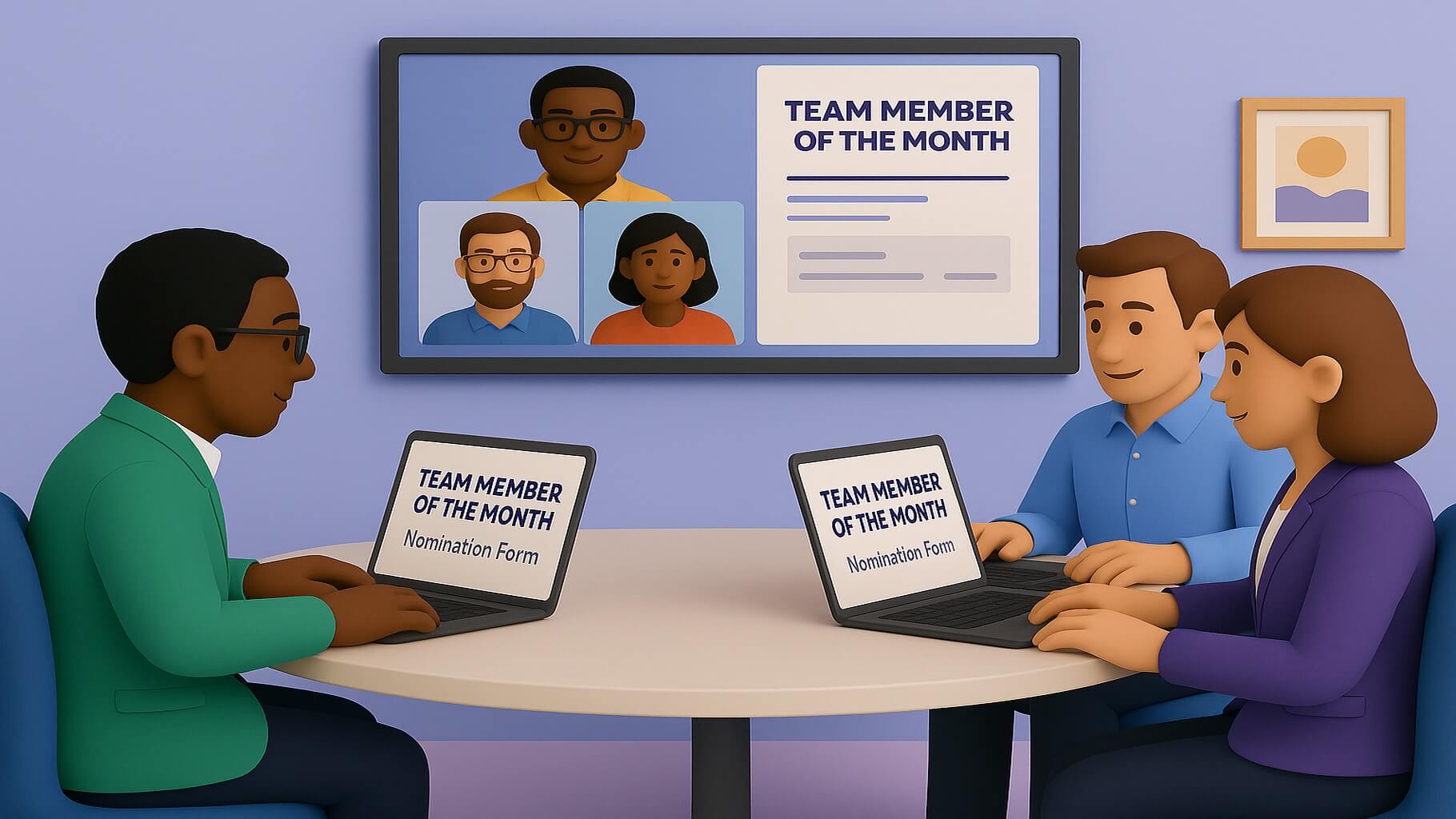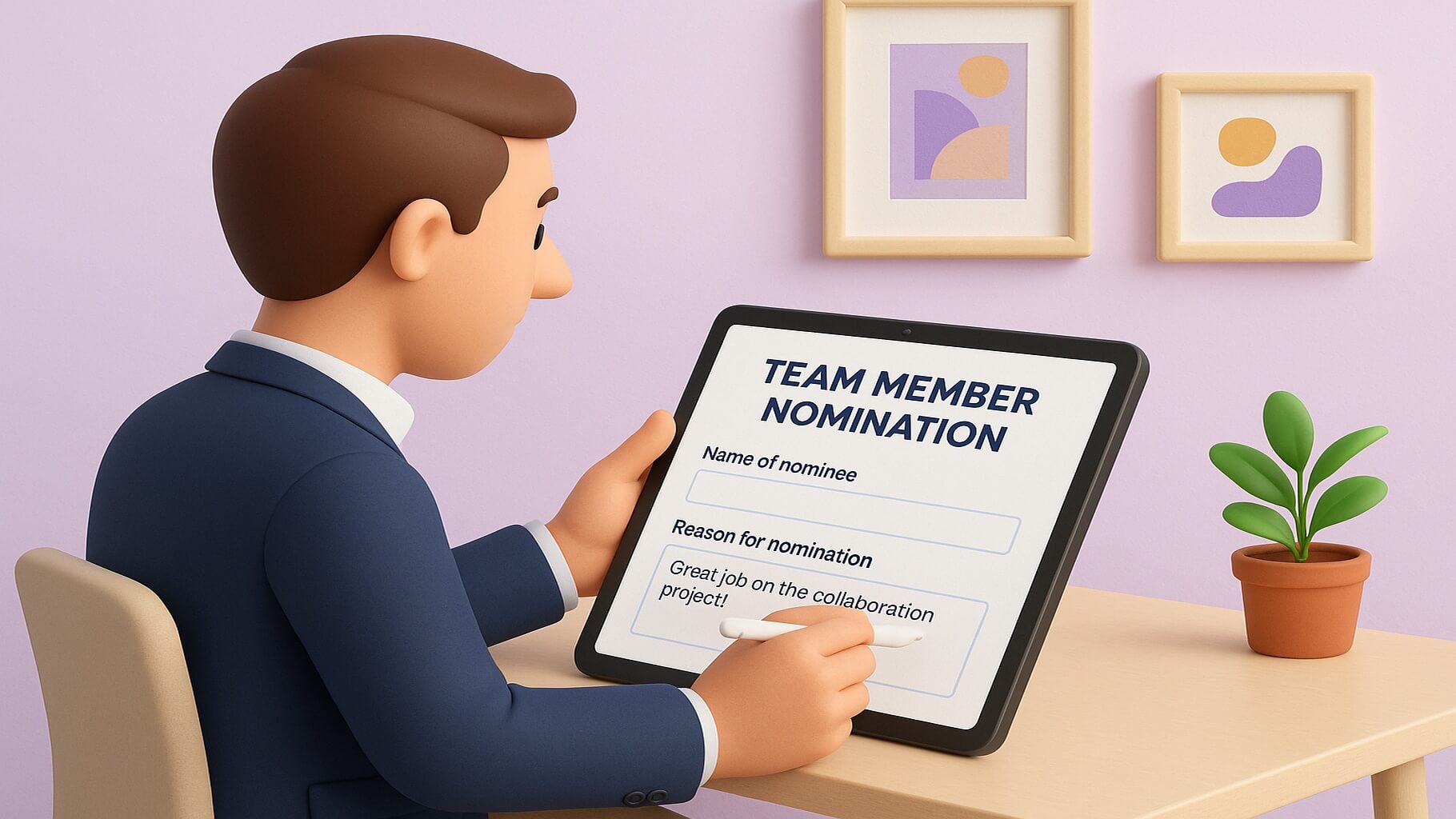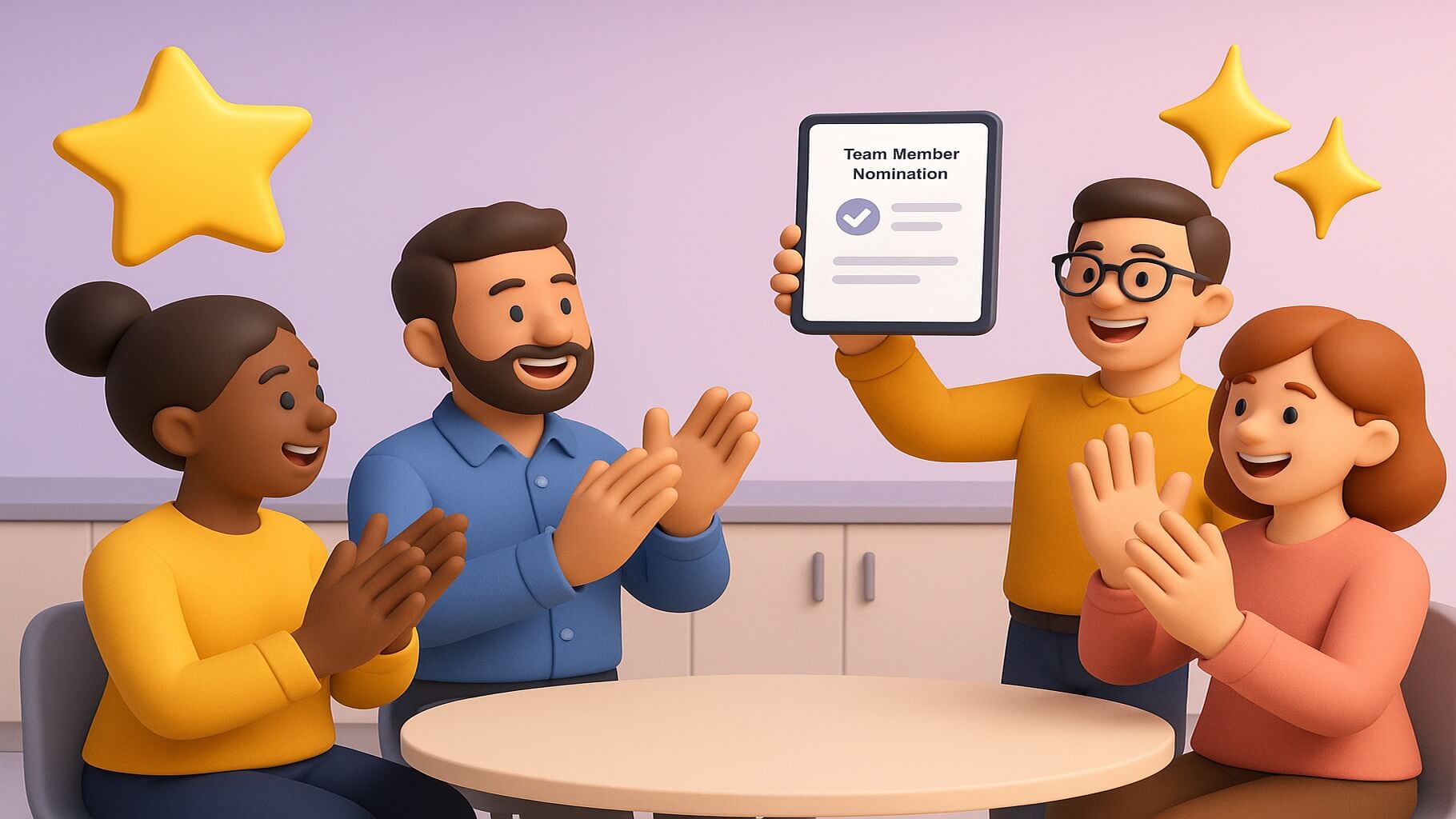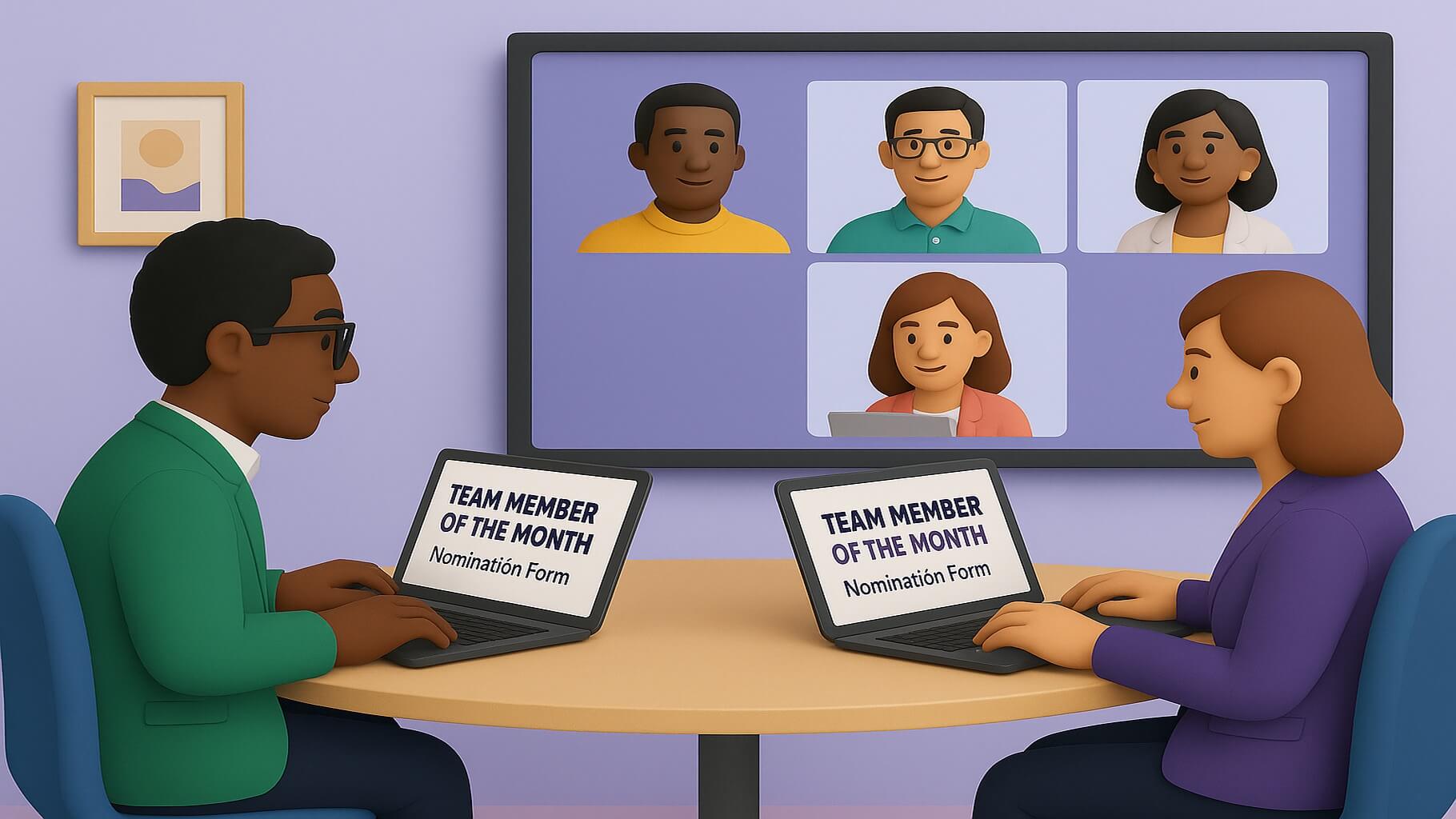
Recognizing outstanding team members through thoughtful nominations not only strengthens workplace culture but also motivates continued excellence. At Matter, we understand that crafting compelling nomination examples can be challenging when you want to genuinely highlight an employee's unique contributions and impact on your department. Many organizations struggle with writing nominations that effectively communicate why a particular team member deserves recognition for their hard work and dedication.
Effective team member nominations require more than generic praise, as they must demonstrate specific examples of how the nominee has exceeded expectations in their position.
Whether you're recognizing leadership initiatives, collaborative support, innovative problem-solving, or consistent professionalism, the most impactful nominations provide concrete evidence of the employee's contributions to their team and organization. This comprehensive guide offers proven nomination examples, templates, and writing strategies to help you create recognition that truly honors exceptional team members.
What are team member nominations?

Team member nominations represent a formal process for recognizing individual employees who demonstrate exceptional performance, leadership, or contribution within their workplace. These nominations serve as documented acknowledgments that highlight how specific team members have positively impacted their department, colleagues, or organizational mission through their dedicated efforts and professional excellence.
Understanding the nomination process helps organizations establish systematic approaches for identifying and celebrating outstanding employee achievements. When committee members review nominations, they evaluate evidence of the nominee's impact, dedication, and alignment with company values to determine award recipients, often using standardized employee nomination form templates that ensure consistent information collection and evaluation criteria.
Understanding team member nomination examples in workplace recognition
Workplace recognition through team member nominations offers a structured method for documenting employee excellence across various performance areas. These nominations typically include detailed descriptions of the nominee's contributions, specific examples of their initiative, and evidence of their positive impact on team dynamics and organizational goals.
Effective nomination examples demonstrate measurable outcomes from the employee's efforts, such as improved processes, successful project completion, or enhanced team collaboration.
The writing should clearly articulate why the nominee deserves consideration for recognition, while providing committee members with concrete evidence to support the award decision. This often involves following established formats, such as employee of the month nomination template structures, which ensure comprehensive documentation.
Key elements of strong workplace nominations include:
- Specific examples of the employee's exceptional performance
- Documentation of how their efforts benefited the team or department
- Evidence of leadership, innovation, or collaborative support
- Clear connection between the nominee's actions and organizational values
How team member nominations differ from whole team award nominations
Individual team member nominations focus on recognizing specific employee contributions, while whole team award nominations celebrate collective achievements and group collaboration. When writing nominations for individual recognition, the emphasis centers on personal initiative, unique skills, and individual impact that distinguishes the nominee from other team members.
Team award nominations highlight collaborative efforts, shared goals, and collective problem-solving that demonstrate effective teamwork. These nominations examine how group members worked together to achieve common objectives, support each other through challenges, and contribute to overall team success.
The nomination process for individual recognition requires a more detailed examination of personal contributions and individual excellence. Committee members evaluate how the nominee's specific actions, leadership, or expertise created positive outcomes that extend beyond typical job responsibilities.
Types of team nomination examples used for individual recognition
Various types of nominations recognize different aspects of employee excellence, including leadership, innovation, collaboration, and professional development. Organizations commonly use performance-based nominations to highlight employees who consistently exceed expectations, demonstrate initiative, and contribute to improved processes or outcomes.
Service-based nominations recognize team members who provide exceptional support to colleagues, clients, or community stakeholders. These nominations often highlight the employee's dedication to assisting others, fostering positive relationships, and contributing to a supportive work environment.
Recognition categories for individual nominations include:
- Leadership excellence for employees who guide and motivate others
- Innovation awards for those who develop creative solutions or improvements
- Collaboration recognition for exceptional teamwork and support
- Professional development acknowledgments for continuous learning and growth
- Employee nomination examples demonstrate various approaches to highlighting individual achievements
Why are team member nominations important?

Team member nominations play a crucial role in building a positive workplace culture by formally recognizing employees who contribute exceptional value to their organization. These nominations provide documented evidence of individual excellence that can support career advancement, professional development, and continued motivation for high-performing team members.
The nomination process creates systematic opportunities for managers, colleagues, and other stakeholders to identify and celebrate outstanding employee contributions. When organizations consistently recognize exceptional performance through formal nominations, they establish clear expectations for excellence. These systematic approaches demonstrate a commitment to valuing employee efforts and achievements through structured programs, such as employee of the month nomination initiatives, which provide regular recognition opportunities.
Benefits of recognizing individual contributors through team member nominations
Formal recognition through team member nominations enhances employee motivation by acknowledging specific contributions and demonstrating organizational appreciation for exceptional performance. When employees receive nominations for their hard work and dedication, they often experience increased job satisfaction and stronger commitment to their position and team.
Recognition programs that include individual nominations help retain talented employees by showing that the organization values their unique contributions and professional growth. These acknowledgments can support career advancement opportunities and provide documented evidence of the employee's impact and excellence for future consideration, particularly when integrated with comprehensive employee recognition platform solutions that streamline the entire process.
The nomination process also benefits managers and department leaders by providing a structured method for identifying top performers and understanding the types of contributions the organization values most. Committee members gain insights into successful practices and employee strengths that can inform training, development, and team-building initiatives.
Impact of team nomination examples on team dynamics and morale
Well-written team member nominations positively influence overall team morale by highlighting examples of excellence that inspire other employees to pursue similar achievements. When team members see colleagues being recognized for specific contributions, they gain a clearer understanding of what types of efforts and initiatives the organization values and rewards.
The visibility of nominations helps establish positive role models within teams and departments, encouraging collaboration and support among team members. Employees often feel motivated to nominate deserving colleagues, creating a culture of mutual recognition and appreciation that strengthens working relationships through comprehensive employee nomination processes that celebrate various forms of excellence.
Regular recognition through nominations also helps address potential morale issues by ensuring that exceptional efforts don't go unnoticed. When employees consistently see their organization celebrating individual achievements, they develop greater confidence that their own contributions will be acknowledged and valued.
Benefits of nomination programs for team dynamics include:
- Increased collaboration as team members support each other's success
- Enhanced communication about achievements and contributions
- Stronger relationships built through mutual recognition and appreciation
- Clear examples of valued behaviors and performance standards
How team award nomination examples strengthen workplace culture
Team member nominations contribute to positive workplace culture by establishing formal recognition practices that celebrate individual excellence and organizational values. When companies regularly acknowledge outstanding employees through systematic nomination processes, they reinforce their commitment to appreciating hard work, innovation, and professional dedication.
These recognition practices help communicate organizational priorities and values by highlighting the types of contributions that receive formal acknowledgment. Employees gain a clearer understanding of what excellence looks like in their specific roles and departments through examples of nominated colleagues' achievements.
The documentation provided through nominations also supports professional development by creating records of individual accomplishments that can inform performance reviews, promotion decisions, and career planning discussions. This systematic approach to recognition ensures that exceptional contributions receive the appropriate acknowledgment and consideration.
For organizations looking to enhance their recognition programs, employee rewards provide additional ways to celebrate individual and team achievements.
17 team member nomination examples by contribution type

Recognizing team members based on their specific types of contributions helps organizations celebrate diverse forms of excellence while providing clear examples of valued behaviors and achievements. These nomination examples demonstrate how different types of employee contributions can be effectively documented and presented to highlight individual impact and value to the organization.
Contribution-based nominations enable committee members to evaluate nominees within their respective contexts, comparing similar types of achievements and ensuring that various forms of excellence receive recognition. This approach enables organizations to maintain comprehensive recognition programs that acknowledge diverse strengths and professional skills across their workforce, much like employee recognition nomination examples can be categorized by contribution type to ensure fair evaluation and comprehensive coverage.
5 leadership within teams nomination examples
Example 1: Project leadership and team guidance
This nominee consistently demonstrates exceptional leadership by taking the initiative on complex projects and guiding team members through challenging situations. Over the last few years, they have successfully managed multiple department initiatives while maintaining high standards and supporting colleague development. Their ability to establish clear goals and motivate other team members has resulted in improved project outcomes and stronger team collaboration.
Example 2: Mentorship and professional development
The nominee shows outstanding commitment to developing junior employees through consistent mentorship and training support. They regularly volunteer to advise new team members, sharing their expertise and helping others understand complex processes and procedures. Their dedication to colleague growth has enhanced overall department capabilities and created a more supportive work environment.
Example 3: Cross-departmental collaboration leadership
This team member excels at leading collaborative efforts between different departments and facilitating effective communication across organizational boundaries. They consistently serve as a liaison for complex projects requiring input from multiple groups, ensuring all stakeholders remain informed and engaged. Their leadership has improved efficiency and reduced misunderstandings between teams.
Example 4: Innovation leadership and implementation
The nominee demonstrates exceptional ability to identify opportunities for improvement and lead the implementation of innovative solutions within their department. They consistently propose excellent ideas that enhance processes and outcomes while collaborating with colleagues to ensure successful adoption. Their initiative has led to measurable improvements in team productivity and quality.
Example 5: Crisis management and team support
During challenging periods, this employee shows remarkable leadership by maintaining team morale and ensuring continued productivity despite difficult circumstances. They consistently support colleagues through stressful situations while efficiently managing their own responsibilities. Their positive attitude and commitment to team success have been instrumental in maintaining department stability during transitions.
5 collaboration and support team member nomination examples
Example 6: Exceptional peer support and assistance
This nominee consistently goes beyond their regular duties to support other team members with projects, training, and problem-solving needs. They maintain a collaborative approach that enhances overall team effectiveness while ensuring their own work meets high standards. Their willingness to help colleagues has significantly improved department productivity and morale.
Example 7: Resource sharing and knowledge management
The nominee demonstrates outstanding commitment to sharing resources, expertise, and knowledge with colleagues across the department. They regularly collaborate on training initiatives and maintain documentation that helps other team members understand complex procedures. Their efforts have improved overall team capabilities and reduced learning curves for new employees.
Example 8: Client service collaboration
This team member excels at working with colleagues to provide exceptional service to clients and stakeholders. They consistently collaborate on challenging cases, sharing insights and resources to ensure optimal outcomes. Their team-focused approach has enhanced client satisfaction and strengthened professional relationships.
Example 9: Interdepartmental communication and coordination
The nominee demonstrates exceptional skill in facilitating communication and coordination among different teams and departments. They regularly serve as a point of contact for complex initiatives requiring input from multiple groups. Their collaborative efforts have improved efficiency and reduced conflicts between different organizational areas.
Example 10: Training and development support
This employee demonstrates remarkable dedication to supporting colleague training and professional development through collaborative learning initiatives. They consistently participate in training programs while helping other team members understand new procedures and systems. Their collaborative approach has enhanced overall department expertise and capability.
For organizations seeking to enhance their collaborative recognition efforts, peer nomination programs provide additional opportunities to celebrate teamwork and mutual support.
5 innovation and problem-solving team member nomination examples
Example 11: Process improvement and efficiency enhancement
This nominee consistently identifies opportunities to improve department processes and develops innovative solutions that enhance efficiency and outcomes. They regularly analyze current procedures and propose changes that reduce waste while maintaining quality standards. Their initiative has resulted in significant time savings and improved team productivity.
Example 12: Technology integration and system optimization
The nominee demonstrates exceptional ability to understand and implement new technology solutions that benefit the entire team. They consistently explore ways to leverage technology for improved efficiency while helping colleagues adapt to new systems and technologies. Their technical expertise and innovation have modernized department operations.
Example 13: Creative problem-solving for complex challenges
This team member demonstrates remarkable skill in developing creative solutions to complex problems that require innovative thinking and resourcefulness. They consistently approach challenges from multiple angles and collaborate with others to find effective resolutions. Their problem-solving abilities have helped the department overcome significant obstacles.
Example 14: Quality improvement initiatives
The nominee demonstrates outstanding commitment to enhancing quality standards through innovative approaches and systematic improvements. They regularly identify areas for enhancement and develop solutions that maintain high standards while improving efficiency. Their dedication to excellence has significantly enhanced the overall department performance.
Example 15: Customer service innovation
This employee excels at developing innovative approaches to customer service that enhance client satisfaction while maintaining operational efficiency. They consistently propose excellent ideas for improving service delivery and collaborate with team members to implement effective solutions. Their innovation has strengthened client relationships and improved service outcomes.
Example 16: Data analysis and insight development
The nominee demonstrates an exceptional ability to analyze data and develop insights that inform decision-making and enhance departmental operations. They consistently use analytical skills to identify trends and opportunities while presenting findings in ways that help colleagues understand complex information. Their analytical contributions have enhanced strategic planning and operational effectiveness.
Example 17: Workflow optimization and coordination
This team member demonstrates remarkable skill at optimizing workflows and coordinating activities to maximize efficiency and minimize conflicts. They regularly assess current processes and propose improvements that benefit the entire team while maintaining quality standards. Their systematic approach has improved the overall organization and productivity of the department.
Organizations looking to enhance their innovation recognition can explore employee incentive programs that specifically reward creative problem-solving and process improvements.
13 team award nomination examples by industry

Industry-specific nominations recognize how exceptional employee contributions manifest differently across various professional settings and organizational contexts. These examples illustrate how the same core principles of excellence, leadership, and dedication manifest in various forms, adapting to the specific demands and challenges of each industry sector.
Understanding industry-specific nomination approaches enables committee members to evaluate contributions within their respective professional contexts, recognizing the unique challenges and opportunities that different fields present. This targeted approach ensures that nominations accurately reflect the specific skills and achievements that matter most within each professional environment, much like staff nomination examples can be tailored to address sector-specific requirements and evaluation criteria.
5 healthcare team member nomination examples
Example 18: Patient care excellence and clinical support
This healthcare team member consistently demonstrates exceptional commitment to patient care while supporting colleagues in challenging clinical situations. They retain the highest levels of professionalism and clinical skill while effectively managing many duties. Their dedication to patient outcomes and team collaboration has enhanced overall care quality and colleague confidence in complex cases.
Example 19: Emergency response and crisis management
The nominee shows outstanding ability to respond effectively during medical emergencies while maintaining calm leadership that supports the entire healthcare team. They consistently provide crucial support during critical situations while ensuring all protocols are followed correctly. Their expertise and composure have been instrumental in successful emergency outcomes and team coordination.
Example 20: Professional development and clinical education
This healthcare professional demonstrates a remarkable commitment to continuous learning and colleague education through training initiatives and knowledge sharing. They regularly participate in professional development while helping other team members understand new procedures and clinical best practices. Their educational efforts have enhanced overall team capabilities and patient care standards.
Example 21: Interdisciplinary collaboration and care coordination
The nominee excels at coordinating care between different medical departments and healthcare professionals to ensure comprehensive patient outcomes. They consistently facilitate communication between various specialists while maintaining detailed documentation that supports continuity of care. Their collaborative approach has improved patient experiences and clinical effectiveness.
Example 22: Quality improvement and safety initiatives
This healthcare team member demonstrates exceptional leadership in developing and implementing quality improvement initiatives that enhance patient safety and care outcomes. They consistently identify opportunities for process enhancement while collaborating with colleagues to establish best practices and safety protocols. Their dedication to continuous development has resulted in significant improvements in patient care quality and team effectiveness.
4 corporate team member nomination examples
Example 23: Strategic planning and business development
This corporate team member demonstrates exceptional ability to contribute to strategic planning initiatives while managing day-to-day responsibilities with remarkable efficiency. They consistently provide valuable insights during planning meetings while developing proposals that support organizational growth. Their strategic thinking and execution have significantly contributed to the business's success and team achievements.
Example 24: Client relationship management and service excellence
The nominee shows outstanding commitment to maintaining and developing client relationships through professional communication and exceptional service delivery. They consistently exceed client expectations while efficiently managing complex accounts and projects. Their client-focused approach has strengthened business relationships and contributed to revenue growth.
Example 25: Financial analysis and reporting excellence
This team member consistently demonstrates remarkable skill in conducting financial analysis and preparing reports that inform strategic decision-making throughout the organization. They consistently provide accurate and timely financial information while helping colleagues understand complex data and trends. Their analytical expertise has enhanced organizational planning and operational effectiveness.
Example 26: Marketing innovation and campaign development
The nominee excels at developing innovative marketing strategies and campaigns that effectively reach target audiences while supporting broader business objectives. They regularly propose creative solutions for challenging marketing problems while collaborating with other departments to ensure successful implementation. Their marketing expertise has enhanced brand recognition and customer engagement.
4 retail and service team member nomination examples
Example 27: Customer service excellence and satisfaction
This retail team member consistently provides exceptional customer service while maintaining positive relationships that encourage repeat business and customer loyalty. They regularly go beyond standard service expectations to ensure customer satisfaction while efficiently managing multiple responsibilities. Their customer-focused approach has enhanced store reputation and sales performance.
Example 28: Inventory management and operational efficiency
The nominee demonstrates outstanding ability to manage inventory systems and maintain operational efficiency during busy periods and seasonal fluctuations. They consistently ensure product availability while minimizing waste and optimizing storage procedures. Their organizational skills have improved store operations and customer satisfaction.
Example 29: Team leadership and staff development
This service team member demonstrates exceptional leadership by supporting colleague training and maintaining positive team dynamics even in challenging situations. They regularly assist with staff development while managing their own responsibilities with professionalism and efficiency. Their leadership has enhanced team morale and overall service quality.
Example 30: Sales performance and customer relationship building
The nominee excels at achieving sales goals while building lasting customer relationships through genuine care and product expertise. They consistently exceed performance targets while maintaining ethical sales practices and customer-focused service. Their sales achievements and customer relationships have significantly contributed to the business's success.
For retail and service organizations, team rewards can provide additional recognition opportunities that celebrate both individual excellence and collaborative achievements.
10 templates for how to write a nomination for a team award

Effective nomination templates provide structured frameworks that help nominators articulate employee achievements clearly while ensuring all essential information is included. These templates guide writers through the nomination process systematically, helping them organize evidence and present compelling cases for recognition that committee members can evaluate effectively.
Well-designed templates also ensure consistency across nominations, making it easier for evaluation committees to compare different candidates fairly. When organizations provide clear formatting guidelines and content requirements, nominators can focus on highlighting the unique contributions and achievements that make their candidates deserving of recognition through structured employee award nomination example formats.
4 formal team member nomination letter templates
Template 30: Executive-level formal nomination format
[Organization Letterhead]
Date: _______________
To: [Award Committee/Recognition Board]
From: [Nominator Name and Title]
Re: Executive Recognition Nomination for [Nominee Name]
Dear Committee Members,
I am pleased to submit this formal nomination for [Nominee Name], [Title], for consideration in the [Award Name] recognition program. In my capacity as [Your Title], I have had the opportunity to observe [Nominee Name]'s exceptional contributions to our organization over [time period].
Nominee Identification:
- Full Name: ________________
- Position Title: _____________
- Department: ______________
- Years of Service: __________
- Reporting Structure: _______
Achievement Descriptions: [Paragraph 1: Describe the nominee's primary achievement or contribution, including specific details, context, and scope of impact.]
[Paragraph 2: Provide additional examples of exceptional performance, including quantifiable results where possible.]
[Paragraph 3: Explain how the nominee's efforts align with organizational values and strategic objectives.]
Supporting Evidence: [Include specific metrics, testimonials, or documentation that validates the nominee's achievements and impact.]
Recommendation: Based on the evidence presented, I strongly recommend [Nominee Name] for [Award Name]. Their exceptional performance and dedication exemplify the standards of excellence this recognition program seeks to honor.
Respectfully submitted,
[Your Signature]
[Your Printed Name]
[Your Title]
[Contact Information]
Template 31: Departmental recognition nomination format
[Department Letterhead]
DEPARTMENTAL NOMINATION FORM
Nominee Background:
- Employee Name: ___________
- Position: ________________
- Department: _____________
- Hire Date: _______________
- Supervisor: ______________
Achievement Summary: [Provide a concise overview of the nominee's key accomplishments during the evaluation period.]
Specific Contributions:
- Leadership: [Describe leadership examples and impact]
- Innovation: [Detail innovative solutions or improvements]
- Collaboration: [Explain teamwork and support provided]
- Professional Growth: [Document development and learning]
Impact Assessment:
On Team: [Describe how the nominee's work affected team performance and morale]
On Department: [Explain departmental benefits from the nominee's contributions]
On Organization: [Detail broader organizational impact]
Quantifiable Results:
- [Metric 1 with specific numbers/percentages]
- [Metric 2 with specific numbers/percentages]
- [Metric 3 with specific numbers/percentages]
Peer Feedback: [Include relevant quotes or observations from colleagues]
Recommendation Statement: [Provide a clear recommendation with reasoning for why this nominee deserves recognition]
Submitted by: ___________
Date: _________________
Contact: _______________
Template 32: Annual award nomination letter format
ANNUAL RECOGNITION NOMINATION
Nominee Information:
Name: ___________________
Position: ________________
Department: _____________
Years with Organization: ___
Evaluation Period: [Start Date] to [End Date]
Year-Long Achievement Summary: [Provide a comprehensive overview of accomplishments throughout the full year]
Quarterly Breakdown:
Q1 Achievements:
- [Key accomplishment with details and impact]
- [Additional achievement with measurable results]
Q2 Achievements:
- [Key accomplishment with details and impact]
- [Additional achievement with measurable results]
Q3 Achievements:
- [Key accomplishment with details and impact]
- [Additional achievement with measurable results]
Q4 Achievements:
- [Key accomplishment with details and impact]
- [Additional achievement with measurable results]
Goal Attainment Documentation:
Goal 1: [Description] |
Status: [Met/Exceeded] |
Results: [Specific outcomes]
Goal 2: [Description] |
Status: [Met/Exceeded] |
Results: [Specific outcomes]
Goal 3: [Description] |
Status: [Met/Exceeded] |
Results: [Specific outcomes]
Professional Development Activities:
- [Training completed with dates and certifications]
- [Skills developed with applications and results]
- [Knowledge shared with colleagues and impact]
Peer Collaboration Examples: [Describe specific instances of exceptional teamwork and support provided to colleagues]
Annual Impact Summary: [Summarize the nominee's cumulative contribution and why they deserve annual recognition]
Nominator: ____________
Title: _______________
Date: _______________
Template 33: Multi-section formal nomination format
COMPREHENSIVE NOMINATION TEMPLATE
SECTION I: NOMINEE QUALIFICATIONS
- Name: __________________
- Title: __________________
- Department: _____________
- Experience Level: ________
- Key Responsibilities: _____
SECTION II: SPECIFIC ACHIEVEMENTS
Achievement 1:
- Description: _____________
- Timeline: _______________
- Outcome: _______________
- Supporting Evidence: _____
Achievement 2:
- Description: _____________
- Timeline: _______________
- Outcome: _______________
- Supporting Evidence: _____
Achievement 3:
- Description: _____________
- Timeline: _______________
- Outcome: _______________
- Supporting Evidence: _____
SECTION III: IMPACT DOCUMENTATION
Team Impact: [Describe specific ways the nominee's work benefited team members and operations]
Departmental Impact: [Explain how contributions improved departmental effectiveness and outcomes]
Organizational Impact: [Detail broader organizational benefits and strategic alignment]
SECTION IV: SUPPORTING EVIDENCE
- Performance Metrics: [Include relevant data and measurements]
- Testimonials: [Quotes from colleagues, supervisors, or clients]
- Documentation: [Reference supporting materials or records]
- Verification: [Contact information for validation if needed]
SECTION V: RECOMMENDATION SUMMARY [Provide compelling conclusion that synthesizes all evidence and makes a clear case for recognition]
Nomination submitted by: _______________
Title and Department: _________________
Date of Submission: ___________________
Contact Information: ___________________
3 structured team nomination example formats
Template 34: Achievement-based structured format
Nominee Information:
Name: _________________
Position: _______________
Department: _____________
Nomination Period: _______
Leadership Examples: [Provide specific examples of how the nominee demonstrated leadership skills, including situations, actions taken, and outcomes achieved.]
Collaboration Instances: [Describe specific examples of the nominee's collaborative efforts, including projects, team support, and cross-departmental work.]
Innovation Descriptions: [Detail innovative solutions, creative problem-solving, or process improvements the nominee contributed, including implementation and results.]
Professional Development Activities: [List training completed, skills developed, certifications earned, or knowledge shared with colleagues during the nomination period.]
Additional Achievements: [Include any other significant contributions that don't fit the above categories but demonstrate exceptional performance.]
Overall Impact Summary: [Summarize how all achievements collectively demonstrate the nominee's value to the organization.]
Template 35: Chronological structured format
Nominee Details:
Name: _________________
Role: __________________
Department: _____________
Timeline Period: [Start Date] to [End Date]
[Month/Quarter/Year]:
Achievement: ___________
Description: ___________
Impact/Results: ________
Supporting Evidence: ____
[Month/Quarter/Year]:
Achievement: ___________
Description: ___________
Impact/Results: ________
Supporting Evidence: ____
[Month/Quarter/Year]:
Achievement: ___________
Description: ___________
Impact/Results: ________
Supporting Evidence: ____
[Continue pattern for additional time periods]
Progression Summary: [Describe how the nominee's contributions have grown or evolved, demonstrating sustained excellence and increasing impact.]
Cumulative Impact: [Explain the overall effect of the nominee's consistent high performance throughout the timeline period.]
Template 36: Competency-based structured format
Nominee Information:
Name: _________________
Position: _______________
Award Category: _________
Competency 1: [Leadership/Communication/Innovation/etc.]
Examples: [Specific instances demonstrating this competency]
Evidence: [Supporting documentation, metrics, or verification]
Impact: [How this competency created positive outcomes]
Competency 2: [Technical Skills/Collaboration/Problem-Solving/etc.]
Examples: [Specific instances demonstrating this competency]
Evidence: [Supporting documentation, metrics, or verification]
Impact: [How this competency created positive outcomes]
Competency 3: [Customer Service/Strategic Thinking/Mentoring/etc.]
Examples: [Specific instances demonstrating this competency]
Evidence: [Supporting documentation, metrics, or verification]
Impact: [How this competency created positive outcomes]
Additional Competencies: [If applicable]
Examples: [Specific instances demonstrating additional competencies]
Evidence: [Supporting documentation, metrics, or verification]
Impact: [How these competencies created positive outcomes]
Competency Excellence Summary: [Explain how the nominee meets or exceeds all required competencies and why they deserve recognition based on the established criteria.]
3 narrative-style team award nomination templates
Template 37: Story-driven narrative format
Nominee Information:
Name: _________________
Position: _______________
Department: _____________
Opening Context: [Describe the situation or environment in which the nominee's story takes place. Include relevant background information about challenges, goals, or circumstances.]
The Challenge: [Detail the specific challenge, problem, or opportunity the nominee faced. Explain why this situation required exceptional effort or skill.]
Actions Taken: [Describe the specific actions the nominee took to address the challenge. Include details about their approach, decision-making process, and any innovative solutions they developed.]
Outcomes Achieved: [Explain the results of the nominee's efforts. Include measurable impacts, improvements, or positive changes that resulted from their actions.]
Broader Significance: [Reflect on how the nominee's achievements demonstrate their character, values, and contribution to organizational success. Connect their story to larger organizational goals or values.]
Template 38: Impact-focused narrative format
Nominee Details:
Name: _________________
Role: __________________
Time Period: ____________
Situation Description: [Set the scene by describing the initial situation, including any problems, goals, or opportunities that existed before the nominee's involvement.]
Nominee's Actions: [Detail the specific steps the nominee took to create positive change. Focus on their initiative, leadership, and unique contributions to the situation.]
Results Achieved: [Describe the measurable outcomes and improvements that resulted from the nominee's efforts. Include specific metrics, feedback, or evidence of success where possible.]
Lasting Effects: [Explain how the nominee's contributions continue to benefit the team, department, or organization. Describe any ongoing improvements or positive changes that stem from their efforts.]
Impact Summary: [Summarize why the nominee's contributions deserve recognition and how they exemplify the values or criteria for this award.]
Template 39: Character-driven narrative format
Nominee Information:
Name: _________________
Position: _______________
Nomination Period: _______
Character Traits: [Identify 2-3 key personal qualities or professional characteristics that make this nominee exceptional. Examples: integrity, innovation, collaboration, leadership, dedication.]
Supporting Examples: [For each character attribute listed, provide particular examples or anecdotes that show these characteristics in action. Include information about the situations, actions, and outcomes.
Colleague Perspectives: [Include observations or feedback from colleagues, supervisors, or other stakeholders who have witnessed the nominee's character in action. Use quotes or paraphrases where appropriate.]
Values in Action: [Describe how the nominee's character traits align with organizational values and contribute to team success. Connect their personal qualities to professional achievements.]
Organizational Impact: [Reflect on how the nominee's character and values create a positive impact beyond their immediate role. Explain why these qualities make them deserving of recognition.]
For organizations developing comprehensive recognition programs, employee recognition and rewards strategies can help integrate various nomination approaches with broader appreciation initiatives.
8 team nomination examples by nomination source

Different nomination sources provide unique perspectives on employee contributions, with each source offering distinct insights based on its relationship and working experience with the nominee. Understanding how various nominators approach recognition helps organizations develop comprehensive nomination programs that capture diverse viewpoints and ensure deserving employees receive appropriate acknowledgment.
The source of a nomination often influences both the content focus and the evaluation criteria used by committee members. Nominations from different sources complement each other by providing multiple perspectives on the nominee's impact, character, and professional contributions within various working relationships and contexts established through effective team nomination examples.
3 manager-submitted team member nomination examples
Example 41: Performance excellence and goal achievement
As the direct supervisor, I nominate this team member for their exceptional performance in consistently exceeding established goals while maintaining high-quality standards. Over the past few years, they have consistently demonstrated remarkable dedication to their position, taking the initiative on complex projects that benefit the entire department. Their commitment to excellence and willingness to support colleagues make them invaluable members of our team.
Example 42: Leadership development and team support
I am pleased to nominate this employee for recognition based on their outstanding leadership development and consistent support of other team members. They regularly volunteer for challenging assignments while mentoring junior staff and helping colleagues understand complex processes. Their positive attitude and professional approach have significantly enhanced team dynamics and productivity.
Example 43: Innovation and process improvement
This nomination recognizes an employee who has consistently contributed innovative solutions and process improvements that have enhanced our department's efficiency and effectiveness. They regularly identify opportunities for improvement while collaborating with colleagues to implement changes that benefit everyone. Their analytical skills and creative thinking have led to measurable improvements in our operations.
3 peer-nominated team member examples
Example 44: Collaborative support and knowledge sharing
We nominate our colleague for their exceptional willingness to share knowledge and provide collaborative support that helps everyone succeed. They consistently make time to help others understand complex procedures while maintaining their own high standards of work quality. Their generous approach to teamwork and genuine concern for colleague success make them deserving of recognition.
Example 45: Reliability and professional excellence
Our team wishes to nominate this member for their remarkable reliability and consistent demonstration of professional excellence in all aspects of their work. They regularly volunteer for additional responsibilities while maintaining positive relationships with all members of the department. Their dependability and positive attitude contribute significantly to our team's success and morale.
Example 46: Problem-solving and creative solutions
We nominate this colleague for their exceptional problem-solving abilities and creative approach to challenges that benefit the entire team. They consistently propose excellent ideas for improving our work processes while helping implement solutions that make everyone more effective. Their innovative thinking and collaborative spirit deserve formal recognition and appreciation.
2 self-nomination team award examples
Example 47: Professional development and skill advancement
I respectfully submit this self-nomination based on my commitment to professional development and the significant skill advancement I have achieved over the past year. Through training programs and independent learning, I have developed expertise that enables me to contribute more effectively to team projects while supporting the development of my colleagues. My enhanced capabilities have enabled me to take on additional responsibilities and contribute to improved department outcomes.
Example 48: Initiative and project leadership
I would like to nominate myself for consideration based on the initiative I have taken in leading several successful projects that have benefited our department and organization. My efforts have yielded improved processes, enhanced team collaboration, and measurable outcomes that support the organization's goals. I believe my contributions demonstrate the type of leadership and dedication that merit recognition through this award program.
Organizations seeking to encourage various nomination sources can benefit from employee nomination strategies that facilitate input from multiple perspectives.
How to write effective team member nominations

Crafting compelling team member nominations requires systematic approaches that combine specific evidence with clear writing techniques to create persuasive cases for recognition. Effective nominations present nominee achievements in ways that help committee members understand both the individual contributions and their broader impact on team success and organizational goals.
Strong nomination writing balances detailed evidence with engaging presentation, ensuring that the nominee's story emerges clearly while meeting all formal requirements of the nomination process. The most successful nominations connect individual achievements to larger organizational values and demonstrate measurable outcomes that justify recognition.
Essential elements for compelling team nomination examples
Compelling nominations include specific examples of the nominee's contributions with clear descriptions of actions taken, challenges overcome, and results achieved. These examples demonstrate how the nominee's efforts exceed normal job expectations, creating a positive impact for colleagues, clients, and the broader organization through their dedication and expertise.
Strong nominations also provide context that helps committee members understand the significance of the nominee's achievements within their specific role and department. This context includes information about typical responsibilities, unique challenges faced, and the nominee's approach to addressing complex situations or requirements through effective employee recognition practices.
Essential elements for effective nominations include:
- Specific examples with measurable outcomes and clear impact descriptions
- Context that explains the significance of achievements within the role
- Evidence of sustained excellence rather than isolated incidents
- Clear connections between nominee actions and organizational values
- Supporting details that demonstrate character and professional commitment
Step-by-step guide on how to write a nomination for a team award
Begin the nomination process by gathering comprehensive information about the nominee's contributions, including specific examples, dates, outcomes, and supporting evidence from colleagues or documentation. This preparation ensures that the final nomination includes compelling details that demonstrate the nominee's impact and value to the organization.
Organize the nomination content using a logical structure that presents information clearly while building a persuasive case for recognition. Start with nominee identification and context, followed by specific achievement examples, evidence of impact, and a summary that reinforces why the nominee deserves consideration for the award.
The writing process should focus on clarity and specificity while maintaining a professional tone throughout. Use active voice and concrete details to make the nomination engaging while ensuring all required information is included according to program guidelines and evaluation criteria.
Steps for effective nomination writing include:
- Research and document specific examples with supporting evidence
- Organize content logically with clear sections and smooth transitions
- Write compelling descriptions that highlight impact and significance
- Review and revise for clarity, completeness, and persuasive impact
- Ensure compliance with all program requirements and formatting guidelines
Writing techniques that make team member nominations memorable
Memorable nominations use vivid, specific language that helps committee members visualize the nominee's contributions and understand their significance. Instead of generic praise, effective nominations include concrete details about actions taken, challenges faced, and outcomes achieved that demonstrate the nominee's exceptional value to their team and organization.
Strong nominations also incorporate storytelling techniques that present the nominee's achievements as compelling narratives with clear progression from situation to action to result. This approach helps committee members connect emotionally with the nomination while understanding the logical case for recognition.
Effective writing techniques for nominations include using specific action verbs, providing quantifiable outcomes where possible, and incorporating colleague perspectives that support the nomination claims. The most memorable nominations balance professional language with genuine appreciation that reflects the nominator's respect for the nominee's contributions.
For organizations seeking to enhance their recognition writing, recognition program development can offer valuable guidance on creating effective nomination processes and evaluation criteria.
Common mistakes in team member nominations

Understanding common nomination mistakes helps organizations refine their recognition processes, ensuring that deserving employees receive fair consideration based on well-written submissions. These mistakes often result from unclear guidelines, insufficient preparation, or a misunderstanding of what evaluation committees value when reviewing nominations for awards.
Avoiding these common errors requires systematic approaches to nomination preparation, clear communication about program requirements, and ongoing training for potential nominators. When organizations address these issues proactively, they can ensure that nomination quality improves while more employees receive appropriate recognition for their contributions through comprehensive employee recognition programs.
Content errors that weaken the team award nomination examples
Generic language and vague descriptions significantly weaken nominations by failing to provide specific evidence of the nominee's unique contributions and achievements. When nominations include phrases like "hard worker" or "team player" without supporting examples, committee members cannot distinguish between different candidates or understand what makes each nominee special.
Incomplete information about the nominee's specific role, responsibilities, and achievements also undermines nomination effectiveness. Committee members need a comprehensive understanding of what the nominee does, how they excel, and what impact their efforts have created to make informed evaluation decisions.
Common content errors include:
- Using generic praise without specific supporting examples or evidence
- Failing to explain the significance of achievements within the role context
- Omitting measurable outcomes or concrete results from nominee efforts
- Including irrelevant information that doesn't support the award criteria
- Neglecting to connect nominee contributions to organizational values or goals
Structure mistakes in team nomination examples
Poor organization makes nominations difficult to read and evaluate, even when they contain strong content about deserving nominees. When nominations lack a clear structure with logical flow from introduction to evidence to conclusion, committee members may miss important information or struggle to understand the nominee's qualifications.
Inconsistent formatting and unclear section divisions also create confusion that detracts from the nomination's persuasive impact. Committee members reviewing multiple nominations benefit from a consistent presentation that allows easy comparison between candidates and clear identification of key qualification areas.
Structural issues that weaken nominations include:
- Lack of a clear introduction that identifies the nominee and the award category
- Missing a logical organization that guides readers through the evidence
- Inconsistent formatting makes the nomination difficult to follow
- Unclear transitions between different types of evidence or examples
- Absent a conclusion that summarizes why the nominee deserves recognition
Evidence gaps that reduce team member nomination impact
Insufficient supporting evidence significantly reduces nomination credibility, particularly when claims about the nominee's achievements cannot be verified or lack specific details. Committee members need concrete evidence to evaluate nominations fairly and confidently recommend award recipients based on documented contributions rather than unsupported assertions.
Missing quantifiable outcomes or measurable results also weakens nominations by making it difficult to assess the true impact of the nominee's efforts. When nominations describe activities without explaining their significance or results, committee members cannot determine whether the achievements merit recognition compared to other candidates.
Evidence gaps that undermine nominations include:
- Lack of specific examples with dates, contexts, and measurable outcomes
- Missing documentation or verification of claimed achievements
- Insufficient details about the nominee's role in collaborative projects
- Absent information about sustained performance over time, rather than isolated incidents
- Limited perspective from only one source, without additional supporting views
Organizations seeking to enhance nomination quality can consider employee rewards platform solutions that streamline the recognition process while ensuring comprehensive documentation of achievements.
FAQ's about team member nomination examples
Q: What makes an effective team member nomination example?
A: Effective team member nomination examples include specific achievements with measurable outcomes, clear context about the nominee's role and responsibilities, and concrete evidence of how their contributions benefit the team or organization. Strong nominations demonstrate sustained excellence rather than isolated incidents while connecting the nominee's efforts to organizational values and goals.
Q: How do you write a nomination for a team award that stands out?
A: Write nominations that stand out by using specific examples with vivid details, measurable outcomes, and clear impact descriptions. Focus on unique contributions that exceed normal job expectations while providing context that helps committee members understand the significance of achievements within the specific role and department environment.
Q: What criteria should team nomination examples address?
A: Team nomination examples should address award-specific criteria while including evidence of professional excellence, leadership impact, collaborative support, innovation, and alignment with organizational values. Include information about the nominee's position, specific achievements, outcomes created, and sustained commitment to excellence over time.
Q: How long should team award nomination examples be?
A: Team award nomination examples should be comprehensive enough to provide complete evidence while remaining concise and focused. Most effective nominations range from one to three pages, depending on program requirements, with clear organization that presents information efficiently without unnecessary repetition or irrelevant details.
Q: What supporting evidence strengthens team member nominations?
A: Supporting evidence that strengthens nominations includes specific performance metrics, colleague testimonials, documentation of achievements, quantifiable outcomes, and verification of sustained excellence over time. Include examples of leadership, collaboration, innovation, and professional development that demonstrate the nominee's comprehensive value to the organization.
Q: When should team nomination examples be submitted?
A: Team nomination examples should be submitted according to program deadlines while allowing adequate time for thorough preparation and review. Submit nominations early enough to ensure all required information is included and properly formatted, with consideration for any additional documentation or verification that committee members may need.
How Matter can help with team member nominations

Matter provides comprehensive solutions for organizations seeking to enhance their recognition culture while ensuring that exceptional employees receive appropriate appreciation for their contributions. The platform offers integrated tools that simplify peer-to-peer recognition and celebration processes while maintaining the quality and consistency needed for effective workplace appreciation programs.
Through Slack and Teams integration and customizable kudos cards, Matter helps organizations establish systematic approaches to employee recognition that capture diverse perspectives while reducing administrative burden. These capabilities enable companies to focus on celebrating excellence through streamlined recognition workflows.
Streamlining recognition collection and tracking
Matter's platform centralizes recognition through user-friendly interfaces that integrate directly with Slack and Teams, allowing employees to give kudos and celebrate achievements seamlessly within existing workflows. The system automatically organizes recognition by various categories while maintaining comprehensive records that support ongoing appreciation efforts.
The platform's analytics capabilities provide visibility into recognition patterns and employee engagement while generating insights that help organizations understand appreciation trends and identify highly recognized team members. This systematic approach ensures consistent recognition while maintaining transparency throughout the process.
Key features for recognition management include:
- Slack and Teams integration for seamless recognition workflows
- Customizable kudos cards for personalized appreciation messages
- Analytics and reporting that track recognition patterns and engagement
- Automated celebration features for birthdays and work anniversaries
Creating standardized recognition templates
Matter enables organizations to develop customizable kudos cards that ensure consistency while accommodating different types of recognition and celebration needs. These templates guide users through meaningful recognition while maintaining flexibility for various appreciation approaches and team cultures.
The platform's customization capabilities allow organizations to align recognition formats with company values and specific recognition goals. This standardization improves recognition quality while making the appreciation process more engaging and accessible for all team members.
Template features that enhance recognition effectiveness include:
- Customizable praise cards that correspond with the corporate values and culture.
- Beautiful design options that make recognition visually appealing
- Easy-to-use interfaces that encourage frequent participation
- Consistent formatting that supports meaningful peer-to-peer appreciation
Using analytics to identify recognition opportunities
Matter's analytics capabilities help organizations track employee recognition patterns and identify team members who consistently receive peer appreciation, suggesting potential candidates for formal recognition programs. These insights enable proactive appreciation while ensuring that deserving employees receive appropriate acknowledgment.
The platform provides data-driven insights into recognition trends and individual achievement patterns that can inform broader recognition strategies. This analytical approach helps organizations ensure comprehensive recognition coverage while identifying employees who demonstrate consistent excellence through peer appreciation.
Analytics features that support recognition insights include:
- Recognition pattern analysis that identifies consistently appreciated employees
- Engagement tracking that highlights active recognition participants
- Team comparison capabilities that ensure equitable recognition across departments
- Trend analysis that reveals recognition patterns and opportunities for improvement
For organizations seeking to develop comprehensive appreciation programs, employee incentive gifts can provide additional recognition opportunities that complement peer-to-peer appreciation with meaningful rewards.
Final thoughts about team member nomination examples

Effective team member nominations help to build a positive workplace culture by ensuring that exceptional employee contributions are recognized and appreciated. These nominations provide documented evidence of individual excellence, while inspiring continued high performance and demonstrating the organization's commitment to valuing employee efforts and achievements.
Organizations that invest in comprehensive nomination processes benefit from improved employee engagement, enhanced retention, and stronger workplace relationships built on mutual appreciation and recognition. When companies systematically celebrate individual achievements through well-written nominations, they create environments where excellence is valued and exceptional contributions are consistently acknowledged.
Building recognition culture through effective team member nominations
A successful recognition culture emerges when organizations integrate systematic nomination processes with broader appreciation initiatives that celebrate both individual achievements and collaborative successes. These comprehensive approaches ensure that various types of contributions receive appropriate recognition while encouraging employees to strive for excellence in their respective roles and responsibilities.
Effective nomination programs also support career development by providing documented evidence of individual achievements that can inform promotion decisions, performance evaluations, and professional growth planning. This systematic approach to recognition helps ensure that exceptional employees receive opportunities that align with their demonstrated capabilities and contributions.
Key elements of recognition culture include:
- Systematic processes that ensure consistent identification and celebration of excellence
- Comprehensive programs that address various types of contributions and achievements
- Clear communication about organizational values and recognition criteria
- Regular opportunities for employees to nominate deserving colleagues and peers
- Integration with career development and advancement planning processes
Measuring the success of team award nomination programs
Organizations can measure the success of their nomination programs through multiple indicators, including participation rates, nominee satisfaction, evaluation process efficiency, and the long-term impact on employee engagement and retention. These metrics help identify program strengths while revealing opportunities for improvement and enhancement.
Regular program evaluation also helps organizations understand which types of nominations are most effective while identifying potential gaps in recognition coverage across different departments, roles, or employee groups. This analysis supports continuous improvement, ensuring that programs remain relevant and impactful over time.
Success measurement approaches include:
- Participation tracking that monitors nomination submission rates and nominator engagement
- Outcome analysis that evaluates award distribution and winner satisfaction levels
- Process efficiency assessment that identifies opportunities for streamlining and improvement
- Long-term impact measurement that connects recognition to engagement and retention outcomes
For organizations looking to enhance their recognition measurement capabilities, employee rewards programs provide additional frameworks for evaluating recognition effectiveness and program impact.
Ready to take your team member nomination process to the next level? Schedule a demo with a Matter expert today and discover how the right tools can help you recognize great work, boost engagement, and support long-term business success.
























